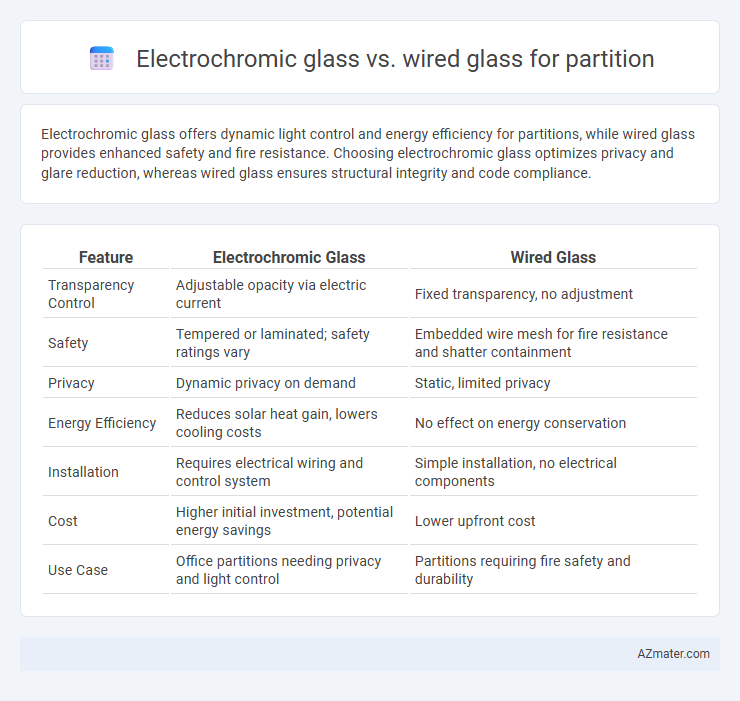Electrochromic glass offers dynamic light control and energy efficiency for partitions, while wired glass provides enhanced safety and fire resistance. Choosing electrochromic glass optimizes privacy and glare reduction, whereas wired glass ensures structural integrity and code compliance.
Table of Comparison
| Feature | Electrochromic Glass | Wired Glass |
|---|---|---|
| Transparency Control | Adjustable opacity via electric current | Fixed transparency, no adjustment |
| Safety | Tempered or laminated; safety ratings vary | Embedded wire mesh for fire resistance and shatter containment |
| Privacy | Dynamic privacy on demand | Static, limited privacy |
| Energy Efficiency | Reduces solar heat gain, lowers cooling costs | No effect on energy conservation |
| Installation | Requires electrical wiring and control system | Simple installation, no electrical components |
| Cost | Higher initial investment, potential energy savings | Lower upfront cost |
| Use Case | Office partitions needing privacy and light control | Partitions requiring fire safety and durability |
Introduction to Electrochromic and Wired Glass
Electrochromic glass utilizes a smart technology that changes tint or transparency when an electrical voltage is applied, enabling dynamic control of light and privacy in partitions. Wired glass consists of embedded metal wire mesh that provides enhanced fire resistance and safety by holding shards together upon breakage, commonly used in partition walls for industrial and commercial applications. Both materials offer distinct advantages: electrochromic glass focuses on adaptable aesthetics and energy efficiency, while wired glass prioritizes structural integrity and fire protection.
How Electrochromic Glass Works
Electrochromic glass changes opacity by applying a low voltage that triggers ions to move between layers, altering the glass's light transmission properties. This smart technology enables dynamic control of privacy and sunlight, unlike wired glass which uses embedded metal wires solely for fire resistance. Electrochromic glass enhances energy efficiency and user comfort by adjusting tint levels on demand, making it ideal for modern partitions.
Wired Glass: Structure and Functionality
Wired glass consists of clear glass embedded with a metal wire mesh that enhances its structural integrity and fire resistance, making it ideal for partitions requiring enhanced safety features. This wire reinforcement prevents glass shattering, providing increased security and durability in high-traffic or hazardous environments. Unlike electrochromic glass, which offers dynamic light control, wired glass maintains consistent transparency while prioritizing fire protection and strength.
Aesthetic Differences Between Electrochromic and Wired Glass
Electrochromic glass offers dynamic tinting capabilities that allow users to adjust opacity and light transmission, enhancing modern, sleek aesthetics with a seamless, high-tech look. Wired glass features embedded metal meshes that create a distinctive, industrial appearance, often used for safety and fire-rated partitions but with a more traditional, patterned design. The visual differences impact interior design choices significantly, as electrochromic glass provides minimalistic elegance while wired glass delivers a rugged, textured style.
Privacy Control: Adjustable Transparency vs. Fixed Opacity
Electrochromic glass offers superior privacy control through adjustable transparency, allowing users to switch from clear to opaque states on demand, enhancing flexibility in partition design. Wired glass provides fixed opacity with embedded wire mesh, ensuring durability and fire resistance but lacking dynamic privacy adjustment. The ability to modulate light transmission in electrochromic glass makes it ideal for spaces requiring customizable privacy without sacrificing natural light.
Safety and Security Considerations
Electrochromic glass offers enhanced safety by allowing instant opacity control, which improves privacy and reduces glare, making it ideal for secure partitioning in offices and healthcare environments. Wired glass provides superior fire resistance with embedded metal mesh to prevent shattering and containment of flames, meeting strict safety codes in industrial and commercial buildings. Choosing between these options depends on prioritizing dynamic privacy and energy efficiency with electrochromic glass or robust fire safety and structural integrity with wired glass.
Energy Efficiency and Environmental Impact
Electrochromic glass enhances energy efficiency by dynamically tinting to control solar heat gain and reduce cooling costs, significantly lowering building energy consumption compared to wired glass, which lacks such adaptive properties. Wired glass, primarily focused on safety and fire resistance, does not contribute to energy savings and typically has higher embodied carbon due to its manufacturing process. The use of electrochromic glass supports sustainable building design by reducing HVAC loads and minimizing environmental impact through better daylight management and improved insulation performance.
Installation and Maintenance Requirements
Electrochromic glass requires professional installation due to its integrated electrical components and control systems, demanding precise wiring and careful calibration to ensure proper functionality. Maintenance involves occasional software updates and cleaning with non-abrasive materials to preserve the smart tinting performance, while addressing potential electrical faults. Wired glass offers simpler installation with standard framing and no electrical setup, requiring minimal maintenance focused mainly on cleaning and periodic inspection for cracks or damage.
Cost Comparison: Upfront and Long-Term Investments
Electrochromic glass typically involves higher upfront costs due to advanced technology and installation expenses, while wired glass is more affordable initially, making it suitable for budget-conscious projects. Over the long term, electrochromic glass offers energy savings and reduced maintenance, potentially lowering total ownership costs, whereas wired glass may incur additional expenses related to damage replacement and energy inefficiency. Evaluating the lifecycle cost and project requirements is essential for balancing initial investment against long-term financial benefits in partition applications.
Choosing the Right Glass for Your Partition Needs
Electrochromic glass offers dynamic light control with adjustable opacity, making it ideal for privacy and energy efficiency in partitions, while wired glass provides enhanced safety and fire resistance due to its embedded metal mesh. Choosing the right glass depends on factors like desired transparency, safety requirements, and budget constraints. For modern office or residential partitions requiring flexibility and style, electrochromic glass is preferred; wired glass suits environments prioritizing fire safety and durability.

Infographic: Electrochromic glass vs Wired glass for Partition
 azmater.com
azmater.com